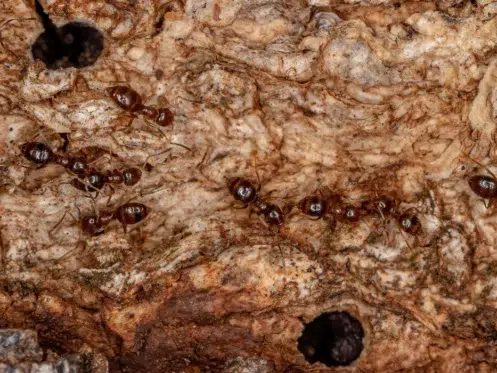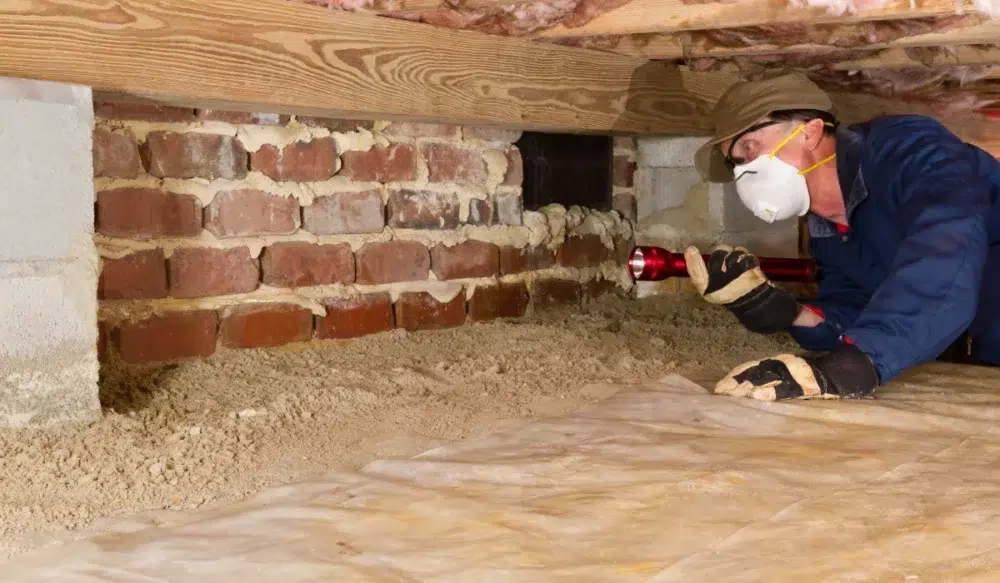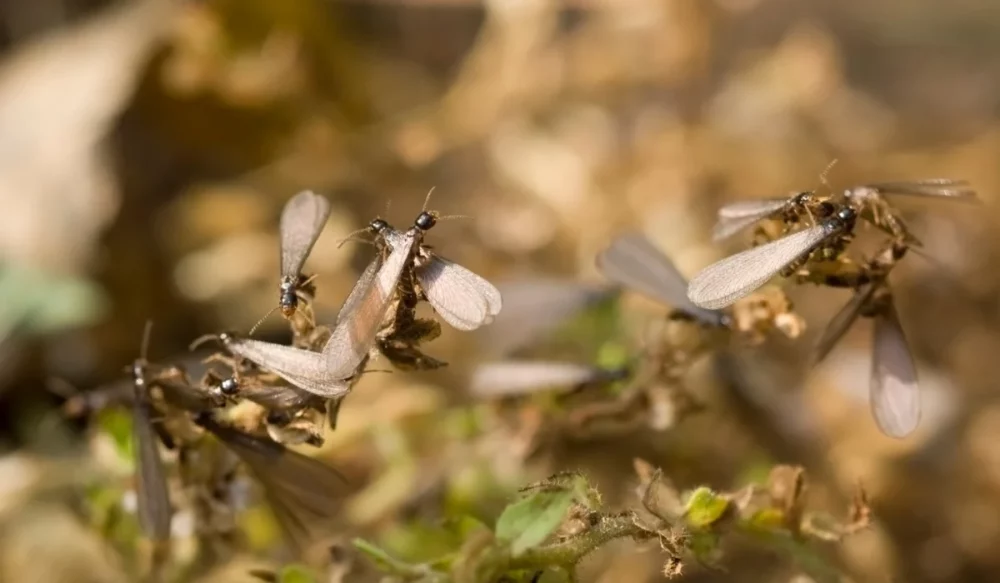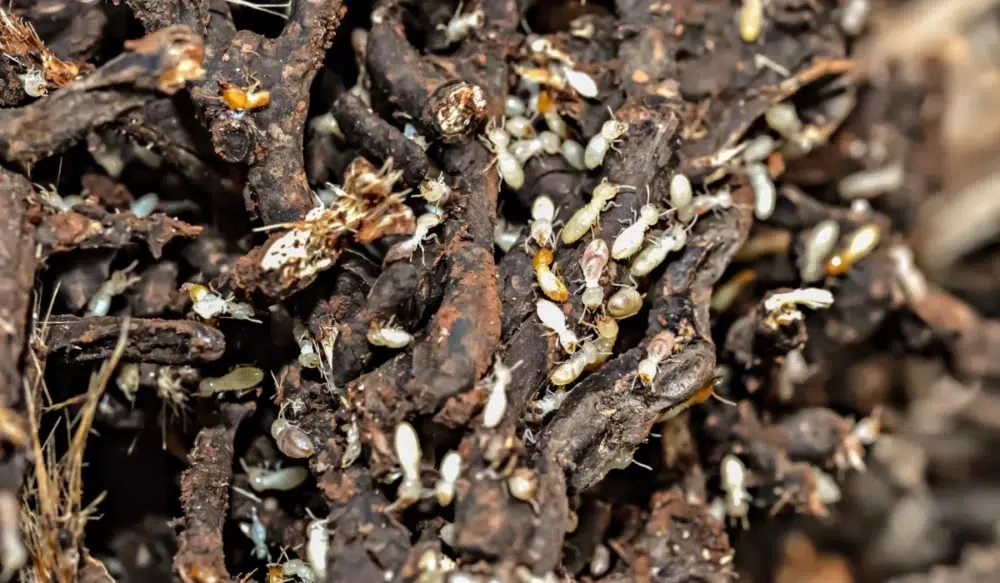If you’re spotting tiny, dark brown ants in your kitchen or bathroom, there’s a good chance you’re dealing with rover ants, also known as dark rover ants. They’re native to South America and have become a widespread nuisance pest across the southern U.S., including Arizona, Texas, and Florida, with Scottsdale being a prime habitat.
These ants don’t have a stinger like fire ants or destroy wood like termites, but they do invade homes in large numbers, making them hard to ignore.
In this guide, you’ll learn how to get rid of them and prevent future infestations, with tips especially relevant for homeowners in Scottsdale.
Key Takeaways
- Rover ants are common in Scottsdale because warm weather and monsoons give them year-round chances to move indoors.
- Small cracks, kitchen messes, and damp areas inside homes give ants easy access to food and nesting space.
- Moist soil, leaking irrigation, aphid honeydew, and stacked firewood make yards a perfect place for ants outside.
- Pest control professionals in Scottsdale safely treat hidden colonies when do-it-yourself steps are not enough to stop ants.
Why Rover Ants Are a Problem in Scottsdale
Rover ant infestations often spike after the monsoon season.
These ants are active during mating flights, when reproductive males and females grow wings and look for new nesting sites. Thanks to Scottsdale’s hot summers and mild winters, there’s rarely a break in ant activity.
What makes them difficult to deal with is how small they are.
Their small size, along with their slim, flexible bodies and short antennae, makes it easy for them to squeeze into tiny entry points in stucco or around plumbing lines.
You may see worker ants trailing in a single file or clustering near moisture sources like sinks and shower drains.
Identify and Seal Entry Points
Rover ants will enter through the smallest of cracks, whether it’s a chipped window frame or a gap in your siding. Scottsdale homes often feature stucco walls, which can hide hairline openings.
Pay special attention to areas near your kitchen, bathrooms, and laundry room. Use weather-resistant caulk and weatherstripping to block those entry points.
You should also check around electrical outlets, plumbing lines, and under baseboards, where these ants love to trail.
Remove Leaf Litter and Wood Piles
In arid climates like Scottsdale, organic materials like leaf litter, tree trimmings, and wood piles create shaded, moist environments that they love. This organic debris serves as both shelter and a source of food.
These pests may establish an ant nest outside and then expand inside your home, especially during the hottest months.
Avoid placing wood mulch directly against your home’s foundation, and keep landscaping materials at least 12 inches away from walls.
Eliminate Food Sources
Ants are constantly foraging, and food sources like crumbs, spilled drinks, or uncovered trash bins can trigger a full-blown invasion. Keep countertops and floors free of sugary residues, especially around pet bowls and trash cans.
Outdoors, manage aphid populations to eliminate honeydew, a major attractant for these pests. If you use any kind of ant bait, make sure it’s designed specifically for rover ants.
Their feeding behavior differs from other species of ants, such as Argentine ants or pavement ants.
Address Potted Plants
Scottsdale residents often rely on potted plants to bring greenery into their desert yards and patios. Unfortunately, these containers are often lined with moist soil, decomposing organic matter, and sometimes mulch, all of which can become nesting sites for ants.
Inspect potted plants for ant activity by tapping the container and watching for movement. If you spot ants, you may need to repot the plant entirely or apply a targeted gel bait near the base.
When to Call a Pest Management Professional
If you’ve tried sealing cracks, cleaning up, and still can’t seem to get rid of rover ant colonies, it’s time to bring in ant control professionals.
The pros may use localized, non-invasive methods to target ant activity where it starts, including wall voids, nesting areas, and high-traffic trails. They may use gel bait or a specialized aerosol treatment to neutralize colonies that are well-hidden.
Prevent Future Rover Ant Infestations
Once you’ve removed the current infestation, the next step is prevention.
Now, it’s time to make sure your yard doesn’t invite them back and get rid of rover ants once and for all. Here are some practical steps that work especially well for Scottsdale’s warm, dry climate:
Monitor Landscaping for Aphids
Plants that host aphids also attract ants, thanks to the sugary honeydew they excrete. Keep an eye on shrubs and flowering plants, and use aphid treatments if necessary. Managing this single food source can reduce ant traffic significantly.
Consulting with an entomologist or reading up on entomology resources can also help you identify plants and pests that may be inviting ants onto your property.
Avoid Overwatering and Fix Leaks
Even in a dry climate like Scottsdale, small leaks in irrigation lines or faucets can provide just enough moisture to support an ant species looking for a home.
Drip lines are especially problematic if they’re buried under mulch or leaf debris. Fix leaks immediately and avoid overwatering your lawn and landscape beds.
Store Firewood off the Ground
Whether you’re keeping wood for winter fires or backyard barbecues, store it properly. Stacked firewood attracts ants and other pests. Use a raised rack to keep the stack dry and place it as far from the house as practical.
This advice applies whether you’re in Arizona, California, Nevada, or even Louisiana, regions where warm weather keeps ant activity high for most of the year.
Ready to Take Back Your Scottsdale Home From Rover Ants?
If you’ve had it with these tiny invaders marching across your kitchen floor or hiding in your wall outlets, you’re not alone. Rover ants can be a challenge, especially when you live in a hot, dry climate like Scottsdale, but you don’t have to fight them alone.
At Green Home Pest Control, our pest management professionals understand the biology and behavior of rover ants and other members of the formicidae family.
Whether you’re dealing with an active ant colony or just want to prevent future invasions, we can build a treatment plan that fits your home, your yard, and your schedule.
Reach out to Green Home Pest Control to schedule a tailored ant treatment for your home




